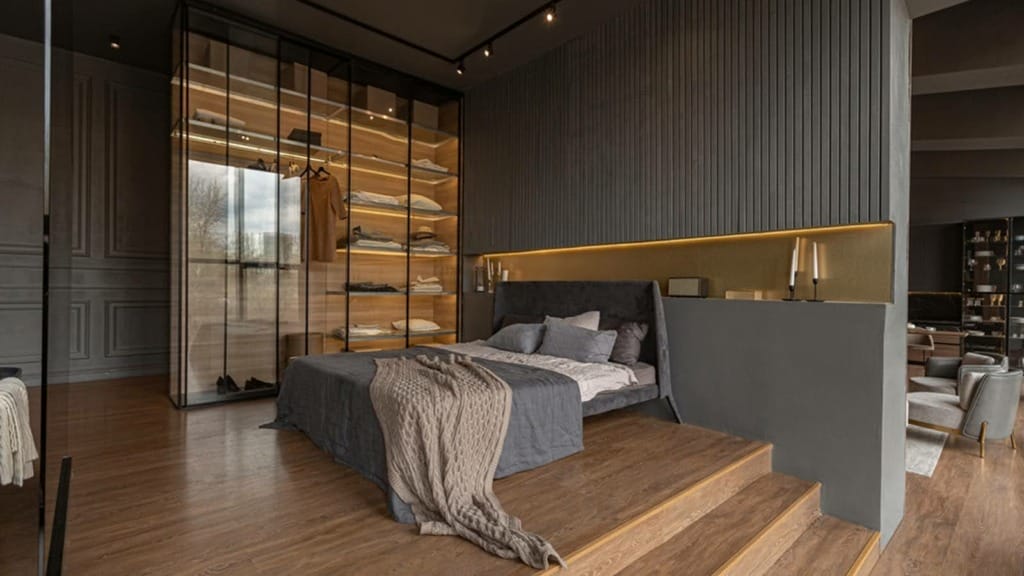Dark wood trim can be one of a home’s most charming features. Rich mahogany or walnut mouldings signal craftsmanship and tradition. However, modern buyers often favor light, bright spaces. This raises a common question for sellers: Should you paint dark wood trim before selling or preserve the natural finish?
This guide explores how dark trim affects buyer perception, the benefits and drawbacks of painting, when it makes sense to paint, and what alternatives you can try.

Understanding the Impact of Dark Wood Trim
In period homes and classic styles, dark wood trim conveys elegance and tradition. Intricately carved casings and baseboards showcase the craftsmanship of the past. If the wood is in excellent condition and matches the home’s architectural style, preserving it can emphasise your property’s unique character. High‑end buyers often appreciate original details, especially in historic or custom homes.
Modern Buyer Perspective
Many contemporary buyers want light, neutral spaces that feel fresh and airy. Dark trim can make rooms feel smaller and dated, particularly when paired with dark floors or cabinetry. Real estate agents note that painting trim white or off‑white brightens interiors and provides a blank canvas.
Light vs Dark: What Sells Better?
Light trim reflects more light and makes ceilings appear higher, which appeals to buyers looking at photos online or touring in person. Dark trim absorbs light and creates strong lines that can make rooms feel segmented.
In small spaces, this can be a drawback. However, dark trim can be an asset in certain contexts: if your home features high‑quality woodwork or if dark accents match the style of the rest of your design, preserving it may resonate with discerning buyers. The key is to consider your market and property style.
Pros of Painting Dark Wood Trim
Painting dark trim offers several advantages:
- Brightens and opens spaces: White or soft neutral trim reflects light and makes rooms feel larger and more inviting. This is especially valuable in small or dimly lit areas.
- Aligns with current trends: Modern buyers gravitate toward bright, neutral finishes. Painting trim signals an updated home and can mask imperfections.
- Creates cohesion: Painted trim provides a consistent backdrop that works with various wall colors, flooring, and décor. It helps unify spaces and makes staging easier. You can introduce trendy accent colors without clashing with wood tones.
- Photographs better: Light trim pops in listing photos, highlighting windows, doorways, and built‑in features. This can attract more online views and showings
- Perceived move‑in readiness: Freshly painted trim conveys that the home is well-maintained and ready for new occupants. Buyers may be willing to pay more for a property that looks finished.
Cons of Painting Your Trim
Despite the benefits, painting trim has drawbacks:
- Permanent change: Once you paint natural wood, it’s difficult and expensive to restore. You lose the grain and warmth that some buyers value.
- Labour and cost: Painting trim requires time, materials, and skill. Professional painters charge by the linear foot, and a DIY project may take longer than expected.
- Maintenance: White paint shows dirt and chips more readily than stained wood. Frequent touch‑ups may be needed, which could deter some buyers.
- Potential buyer preferences: In historic districts or higher‑end markets, buyers may prefer original wood details. Painting trim could turn off these customers. Again, consider your location and target buyer.
When Painting Dark Trim Makes Sense
There are several scenarios where painting dark trim is a smart choice:
- Low‑light or small rooms: Dark trim absorbs light and makes compact spaces feel smaller. Painting it white reflects light and visually expands the room.
- Outdated interiors: If your trim is thin, mismatched or clashes with new flooring or cabinetry, painting can unify finishes and modernise the look.
- Competitive markets: When buyers have many homes to choose from, small updates can set yours apart. Painting trim is a cost‑effective way to show you’ve invested in the property.
- Vacant properties: Without furniture to add interest, painted trim can brighten and define spaces. Combined with neutral wall colors, it helps buyers imagine themselves in the home.
If you decide to paint, hire a professional for a smooth finish or follow proper prep steps: clean, sand, prime, and apply two coats of high‑quality paint.
Alternatives to Painting Trim
Painting isn’t the only way to modernise dark wood trim. Consider these options:
- Light wall colors: Soft whites, creams, pale grays, or subtle blues brighten rooms and reduce contrast with dark trim. This makes the trim feel intentional rather than outdated.
- Strategic staging: Use light furniture, neutral rugs, and reflective surfaces to draw attention away from heavy trim. Mirrors, metallic accents, and bright textiles make the space feel airier. Our guides on soft staging and selling faster with occupied staging offer more ideas.
- Selective painting: If you can’t commit to painting every piece, consider painting only baseboards or trim in certain rooms, such as bathrooms or bedrooms. This approach lightens specific areas while preserving some wood character.
- Accentuate dark trim: Sometimes, embracing dark wood works. Pair it with warm neutrals, leather furniture, and natural materials for a cohesive, traditional look. This is a good option for historic homes.
Expert Home Stager Advice
Professional stagers and real estate agents generally recommend painting dark trim to appeal to a broader audience. White trim photographs better, highlights architectural details and aligns with current buyer preferences.
We advise painting thin or mismatched trim if resale is important. However, stagers also recognise the beauty of natural wood. In homes with exceptional craftsmanship or in markets that value historic charm, leaving the trim unpainted may be the right choice. Agents suggest looking at comparable sales: if most homes in your area have painted trim, follow suit. If preserved woodwork is part of the neighbourhood’s appeal, consider leaving it as is.
Final Verdict: Paint or Preserve?
Whether to paint dark wood trim before selling depends on your home’s style, the local market, and your budget. Painting can brighten rooms, modernise dated finishes and increase buyer appeal, especially in small, dark or contemporary spaces. It signals a well‑maintained, move-in-ready home and may help you sell faster. On the other hand, painting is permanent, requires labour, and can diminish the charm of high‑quality woodwork. If your home features beautiful original trim or is located in a historic district, leaving the wood as is could attract buyers who appreciate its character.
If you’re undecided, test the waters by painting trim in a secondary room or painting only baseboards. Lighten the walls and use strategic staging to minimize contrast. Ultimately, the goal is to create a cohesive, inviting interior that resonates with the widest range of buyers.
For more ideas on updating your home, explore our article on the latest home redesign trends in Edmonton for 2025.
Before making a final decision, look at comparable homes in your neighbourhood and consult local real estate professionals. They can offer insight into what buyers expect in your market and price range. If you’re working within a tight budget or timeline, remember that thoughtful staging can often compensate for dated trim. Light paint on the walls, neutral furnishings, and reflective surfaces make dark woodwork feel intentional and elegant.
For step‑by‑step staging strategies, see our guide on how to stage homes for open houses.
FAQs
Q1: Will painting dark wood trim increase my home’s value?
It may not directly add dollars, but it enhances buyer appeal. Homes with light, neutral trim often sell faster and closer to the asking price because buyers perceive them as updated and move‑in ready.
Q2: What colour should I paint the trim if I choose to do it?
Neutral whites or soft off‑whites brighten rooms and complement most wall colours.Avoid stark, bright whites that can look harsh.
Q3: Should I paint trim in every room or just a few?
Consistency is key. Painting trim throughout the main living areas creates a cohesive look. However, you can test paint in a secondary room before committing.
Q4: How much does it cost to paint dark wood trim?
Professional painters typically charge $2–$3 per linear foot. DIY can save money but requires time, tools, and patience. Get quotes to compare options.
Q5: Can I stage around dark trim instead of painting?
Yes. Use light walls, furnishings, and décor to balance dark trim. Mirrors and metallic accents reflect light. Our soft staging guide offers more tips on working with existing features.


